Reaction doodles offer a fun way to express emotions without words. Quick emotion circles, color-coded scribbles, and expressive face templates can capture feelings instantly. Try directional arrows for shifting moods or abstract line work for complex emotions. Layered techniques work great for mixed feelings, while spontaneous brush strokes release stress. Creating your personal symbol library makes emotional communication easier in texts and journals. These simple visual tools reveal a whole new language of self-expression.
Key Takeaways
- Color-coded emotional scribbles transform simple marks into powerful visual maps of feelings without requiring artistic skill.
- Quick emotion circles provide an accessible way to represent complex emotions using basic shapes and colors.
- Creating a personal emotional symbol library helps build a visual shorthand for expressing different emotional states.
- Directional arrow doodles effectively track emotional journeys through varied line styles like zigzags for anxiety.
- Layered doodle techniques combine different colors and patterns to capture complex, mixed emotional states authentically.
Quick Emotion Circles: Capturing Feelings in Simple Shapes
Circles, the universal shape of wholeness, become powerful tools for emotional expression when used in Quick Emotion Circles. This fun technique transforms basic shapes—circles, ovals, and simple lines—into visual representations of complex emotions.
Anyone can grab a pen and start doodling their feelings without worrying about artistic talent!
Pick up a pen and let your emotions flow—artistic skill optional, authentic expression guaranteed!
The beauty of these cartoony emotion circles lies in their accessibility. Feeling angry? Draw jagged lines bursting from a red circle. Overwhelmed? Maybe that’s overlapping circles in different colors.
These quick doodles create an immediate visual language that speaks volumes without words. Kids especially love how these simple shapes let them express big feelings they might struggle to name.
As a warm-up exercise, emotion circles help people ease into deeper emotional work, turning abstract feelings into something they can literally see and share.
Directional Arrow Doodles for Shifting Moods
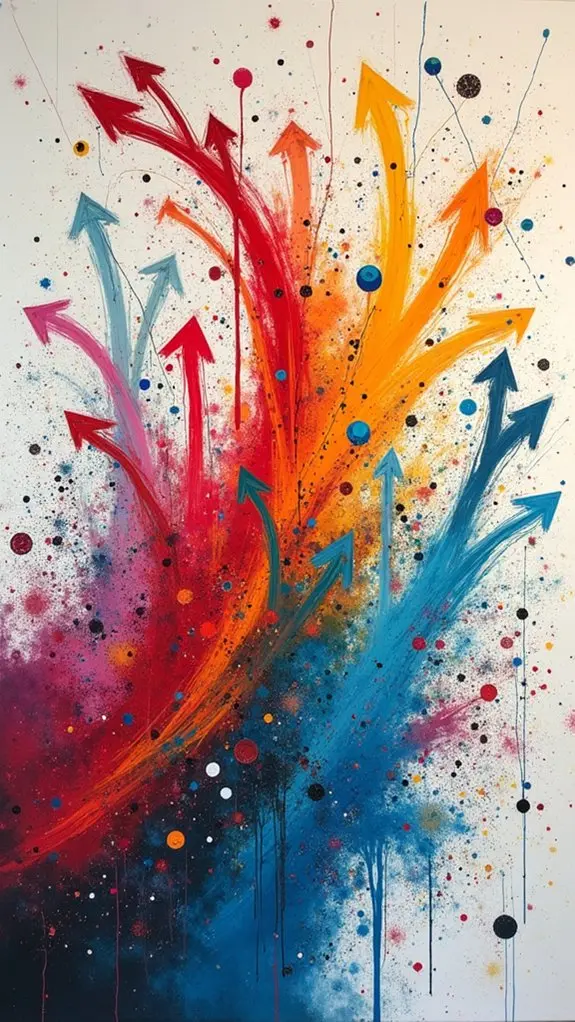
Directional arrow doodles offer a fascinating way to track the ups and downs of our emotional journeys through simple, flowing lines.
When arrows curve and bend across the page, they reveal the natural pathways our feelings take throughout the day or week.
These expressive arrows don’t just point somewhere—they tell the story of how our moods shift, jump, spiral, or zoom from one emotional state to another.
Curved Pathways Reveal Feelings
When our emotions shift and change like the weather, doodles can capture that journey in surprising ways. Curved pathways in doodles turn simple lines into emotional stories that flow across the page, bending and winding like our feelings do throughout the day.
These flowing lines can connect different emotions for design characters, showing how one feeling leads to another. When we’re happy, our curved arrows might soar upward with bouncy loops, but when sadness creeps in, those same pathways might droop or spiral inward.
Decorative brush stroke lines add texture and personality to these emotional maps, making each doodle uniquely expressive.
Next time you’re feeling a jumble of emotions, try drawing curved arrows to see where your feelings take you – it’s like creating a roadmap of your heart!
Arrows Express Emotional Direction
Arrows can be powerful emotional messengers in our doodles, showing not just how we feel but where those feelings are heading. When we add directional arrows to our expressive scribbles, we transform static emotions into dynamic journeys that tell deeper stories about our moods.
| Arrow Type | Emotion | Visual Effect |
|---|---|---|
| Zigzag | Anxiety/Stress | Chaotic energy |
| Curved | Shift/Flow | Gentle movement |
| Bold straight | Determination | Direct purpose |
| Spiraling | Confusion/Wonder | Swirling thoughts |
The style of arrows matters just as much as their direction! A jagged, sketchy arrow might show frustration, while a smooth, flowing arrow could represent hope or relief. Trying different arrow designs with your emotional doodles creates a visual language that captures how your feelings aren’t just existing—they’re moving, changing, and taking you somewhere new.
Expressive Face Templates for Daily Mood Tracking
Expressive face templates offer a fun way to keep track of your changing moods throughout the day with simple, quick drawings anyone can create.
These customizable faces, ranging from beaming smiles to dramatic frowns, act as visual snapshots that capture how you’re feeling without needing to write lengthy journal entries.
Students can personalize their mood trackers by adding wild hair, tears of joy, steam clouds above angry brows, or even color-coding different emotions to create a visual diary that’s uniquely theirs.
Quick Daily Trackers
Simple facial expressions can track your emotional rollercoaster in a fun, visual way! Quick daily trackers using hand-drawn cartoony expression signs help you spot patterns in how you’re feeling. These little faces become emotions for creation characters in your personal story—turning your moods into a visual journey anyone can understand at a glance!
| Mood Type | Morning Face | Evening Face |
|---|---|---|
| Happy Days | 😄 | 😊 |
| Tough Times | 😔 | 😴 |
| Mixed Feelings | 😐 | 🙃 |
Try setting up a weekly grid in your journal or planner. Each day, just doodle the face that matches your mood. After a while, you’ll see cool patterns—maybe Mondays aren’t so awful, or rainy days actually boost your spirits!
Customizable Expression Templates
Making your own face templates takes daily tracking to a whole new level! Customizable expression templates allow anyone to create personal mood trackers that actually look like them. With 30 emoji doodle emotions in vector format, users can easily represent feelings from super excited to totally bummed out.
The face expression set includes options for happiness, sadness, anger, and surprise—everything needed to capture those daily emotional rollercoasters. Kids can change eye shapes, mouth curves, and even add fun accessories like tears or steam clouds!
Imagine drawing a different face each day that perfectly matches your mood. These visual trackers help build self-awareness too, making emotional reflection something to look forward to rather than skip.
Who knew tracking feelings could be so creative and fun?
Abstract Line Work to Represent Complex Emotions
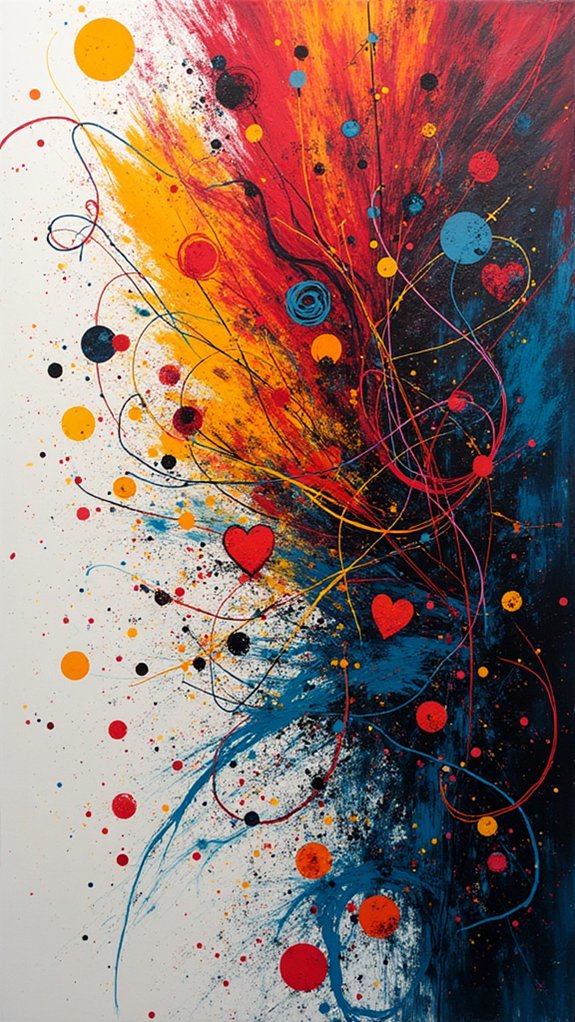
The chaos and beauty of our inner emotional world can be translated into fascinating abstract line work on paper. Artists can use thick, bold strokes to show anger, or delicate, wispy lines for sadness.
By combining spirals, jagged edges, and flowing curves, anyone can create a cartoony expression sign doodle that reveals complex feelings without words.
Different line patterns speak their own emotional language—straight lines suggest stability, while zigzags might represent anxiety or excitement. Doodlers can enhance their emotions handmade art by adding splashes of color; red might intensify anger, while cool blues can deepen feelings of calm or melancholy.
This creative practice isn’t just fun—it’s actually good for your brain! When you draw your feelings, you’re processing them in a new way, which can help you understand yourself better.
Color-Coded Emotional Scribbles and What They Reveal
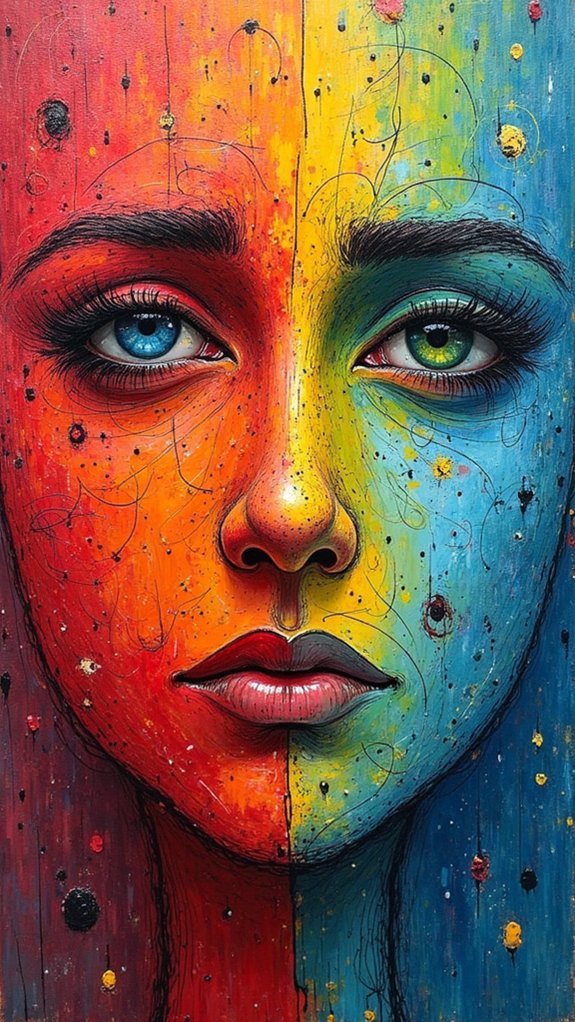
Moving from abstract lines to the world of color brings a whole new dimension to emotional doodling. With color-coded emotions, people can transform messy scribbles into a visual map of their feelings. Imagine using fiery red swirls for anger or gentle blue waves for sadness!
When someone picks up markers and lets their emotions flow, expressive art happens naturally. The colors they choose often reveal hidden feelings they might not even realize they have.
Over time, these colorful doodles can show patterns—like always reaching for yellow when feeling anxious. Scientists have found that this kind of emotional processing helps people understand themselves better.
It’s like giving your feelings a secret language that only you need to understand! Plus, it’s way more fun than just writing down how you feel.
Character-Based Reaction Symbols for Journaling
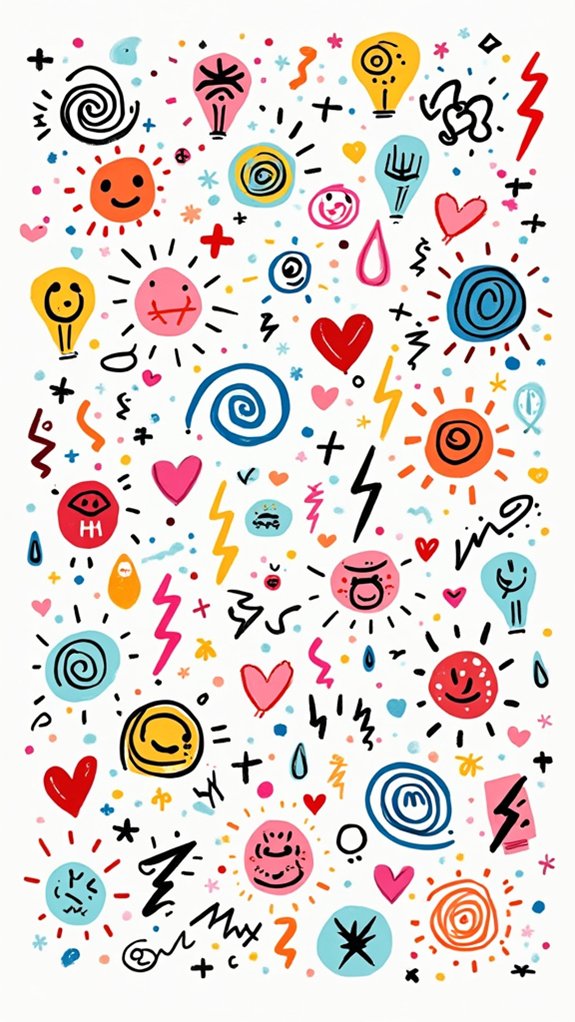
While doodles can express emotions through colors and lines, character-based reaction symbols take journaling to a whole new level of expressiveness. These tiny emotional ambassadors transform feelings into visual stories that anyone can understand at a glance.
Journal enthusiasts can incorporate emoticon effects design elements with playful brush strokes to create personalized reaction characters that truly reflect their inner world.
Creating a library of doodle emotions for creation helps journalers quickly capture feelings when words seem inadequate. Imagine having a grumpy cloud for bad days, a bouncing star for excitement, or a melting ice cream cone for disappointment!
These symbols become a visual language that makes flipping through journal pages like watching an emotional highlight reel. Plus, sketching these characters offers a moment of creative reflection, turning emotional processing into art.
Layered Doodle Techniques for Mixed Emotions

Life rarely gives us just one feeling at a time – sometimes we’re happy but nervous, or sad yet hopeful.
Layered doodle techniques offer the perfect solution for capturing these complex emotional states in your journal or artwork.
Try combining different line styles—perhaps wavy lines for anxiety underneath bold strokes for confidence. By overlapping contrasting colors, like sunny yellows with cool blues, your emotional expression becomes instantly more authentic.
Many artists create depth by incorporating symbolic elements: a heart with raindrops, or sunshine peeking through clouds.
The magic happens in the layers! Each new addition creates visual engagement that mirrors how feelings interact in real life.
Plus, it’s super fun to experiment with different textures and patterns. The more you practice layering, the better you’ll get at translating your jumbled feelings into something you can actually see.
Spontaneous Brush Stroke Emotions for Stress Relief

Spontaneous brush strokes offer a powerful way to release bottled-up feelings without needing artistic skill or planning.
The Calming Swirls Technique uses gentle, flowing movements to melt away anxiety, while Bold Anger Releases encourage sharp, jagged strokes that physically channel frustration onto paper.
Meditative Line Therapy, which involves drawing continuous, mindful lines without lifting your tool, helps quiet a racing mind and brings you back to the present moment—just like taking a deep breath for your brain.
Calming Swirls Technique
Every person needs an outlet for their emotions, and the Calming Swirls Technique offers exactly that through simple, flowing brush strokes. This expressive technique invites people to create spontaneous, circular movements that represent their feelings without words. The soft, flowing motions naturally calm the mind while letting emotions surface on paper.
Research shows these emotional symbols can notably reduce anxiety levels when practiced regularly. Kids love watching their feelings transform into colorful patterns! The technique works as a visual emotional check-in, helping identify feelings that might otherwise remain buried.
When creating calming swirls, there’s no right or wrong way to do it—just let the brush dance across the page while breathing deeply. The mind becomes focused on the present moment, making this both art and meditation rolled into one colorful package.
Bold Anger Releases
When anger boils over and words fail to capture the intensity, Bold Anger Releases offer a powerful solution through art. This expressive technique uses spontaneous brush strokes to transform frustration into visual energy on paper.
The Vector set of hand-drawn elements creates a raw, authentic representation of emotions that might otherwise remain bottled up.
- Create jagged, thick lines with heavy pressure to physically release tension
- Use vibrant reds and blacks to visually represent your emotional temperature
- Draw cartoon character emotion symbols with exaggerated features and steam clouds
- Scribble rapidly without lifting your pen for maximum cathartic effect
- Incorporate sharp angles and lightning bolt shapes to symbolize your anger’s intensity
This doodling method isn’t just about looking cool—it’s a healthy way to process feelings before they explode!
Meditative Line Therapy
Unlike its bold and energetic cousin, Meditative Line Therapy offers a gentler approach to emotional expression through art. By creating spontaneous brush strokes, anyone can tap into their feelings without worrying about artistic talent. The magic happens when you focus on the physical movement of drawing, letting your emotions flow through your hand and onto the page.
Different line styles—light, dark, wavy, or straight—become a visual language for complex emotions. Fast, jagged lines might show anxiety, while slow, flowing strokes could express peace. This mindfulness practice helps people recognize when they’re feeling multiple emotions at once, like being both excited and nervous.
Many find that regular emotional check-ins using meditative line therapy creates a calming ritual, offering a break from stress while building self-awareness through creative play.
Creating Your Personal Emotional Symbol Library
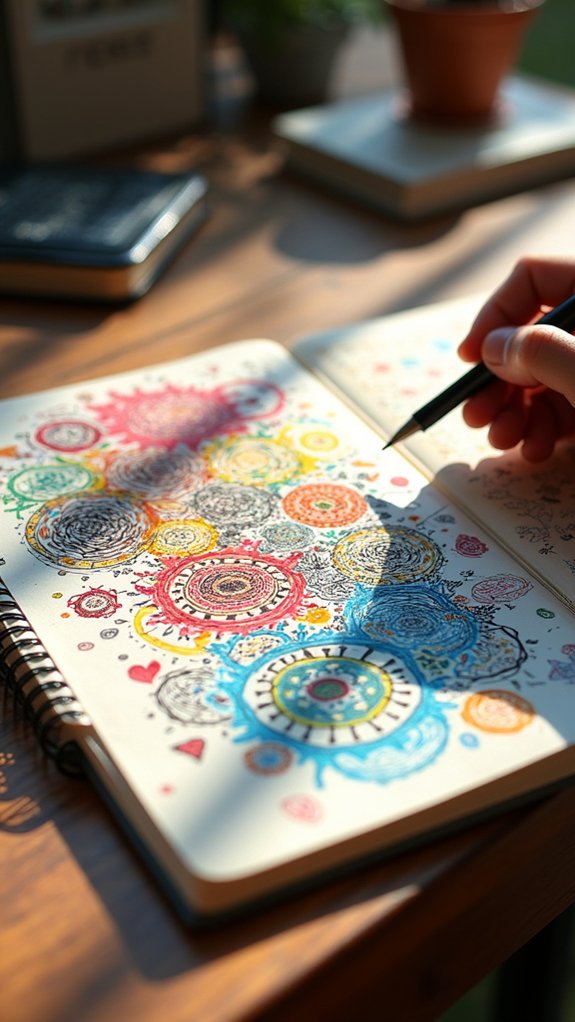
Developing a personalized library of emotional symbols opens up a whole new world of self-expression in your doodle art. Artists can transform their feelings into visual shorthand by assigning unique colors or shapes to different emotions.
Unlock your feelings through visual shorthand—where colors and shapes become the vocabulary of your emotional doodle language.
Whether using cute decorative brush strokes or comic-inspired expressions, various doodle styles help capture the full spectrum of human feelings.
- Start with basic emotions (happy, sad, angry) and expand to more complex ones (nostalgic, anxious, peaceful)
- Create a mini-dictionary with color codes for quick emotional reference
- Mix symbols together to represent complicated feelings
- Practice drawing your symbols until they become second nature
- Review and update your library monthly as your emotional vocabulary grows
This personal expression toolkit becomes your secret language, telling stories without words!
Transforming Text Messages With Reaction Doodles
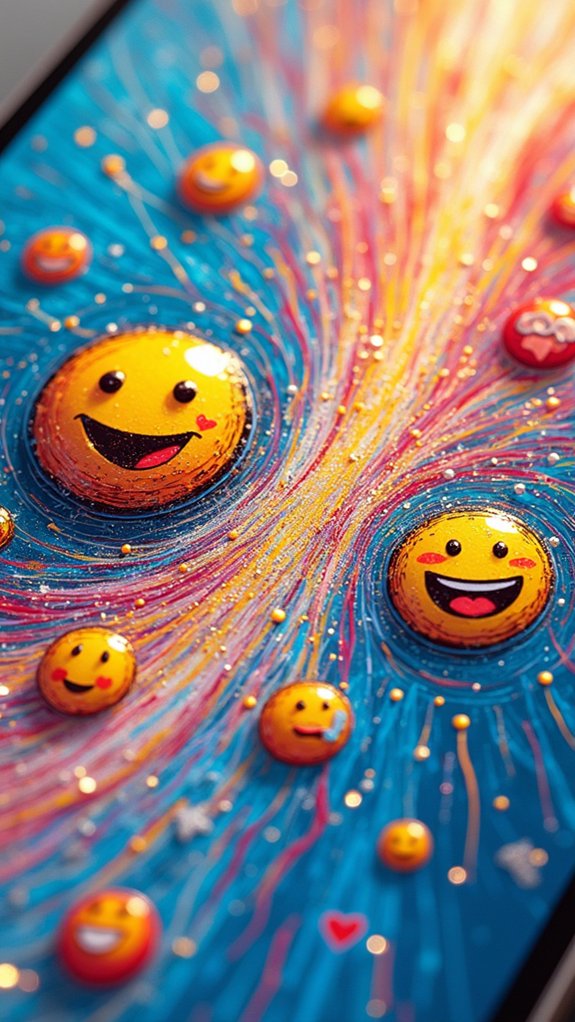
Once you’ve created your emotional symbol library, the real magic happens when you bring these visual expressions into your everyday conversations.
Adding reaction doodles to messages transforms plain text into vibrant, emotionally-rich exchanges that capture exactly how you’re feeling.
When a friend shares exciting news, a quick happiness spiral or star-burst doodle says more than “congratulations” ever could! These expressive scribbles reduce misunderstandings too, since a message with a tiny heart or sad face clearly shows your tone.
Emotional symbols work wonders in group chats, where conversations move quickly and feelings might get lost. A surprised face doodle or confused squiggle next to your text helps everyone understand your reaction instantly.
Plus, your friends will appreciate the personal touch that makes your messages uniquely you!
Frequently Asked Questions
Can Reaction Doodles Be Interpreted by Therapists for Psychological Insights?
Therapists can analyze spontaneous drawings for therapeutic insights, examining symbol interpretation within emotional expression. These visual projections often reveal subconscious patterns that complement verbal communication in psychological assessment.
How Do Artistic Abilities Affect the Therapeutic Value of Emotional Doodling?
Artistic abilities minimally impact emotional doodling’s therapeutic benefits. The process of emotional release through artistic expression matters more than technical skill in achieving meaningful psychological outcomes.
Are Specific Art Supplies Better for Creating Meaningful Reaction Doodles?
Art supplies vary in therapeutic potential. Graphite pencils offer control for detailed emotions, colored markers provide vibrant spontaneity, while watercolor paints allow fluid expression through gentle color blending and unpredictable movement.
Can Children Benefit From Reaction Doodling for Emotional Development?
Children develop emotional awareness through reaction doodling, transforming feelings into creative expression. This visual processing builds social skills as they learn to recognize, communicate, and regulate emotions through simple drawings.
Do Cultural Backgrounds Influence Emotional Symbol Interpretations in Doodles?
Cultural symbolism greatly influences doodle diversity. Emotional expression through spontaneous drawing varies across societies, with symbols carrying different meanings based on cultural traditions and collective experiences.
Conclusion
Reaction doodles offer everyone a creative way to express feelings when words just aren’t enough. These simple drawings become a personal visual language that can transform moods, capture complex emotions, and add personality to everyday communication. By developing their own symbol library, students can better understand their emotional terrain while having fun. So grab those pens and let those feelings flow onto paper—sometimes the perfect response is just a scribble away!

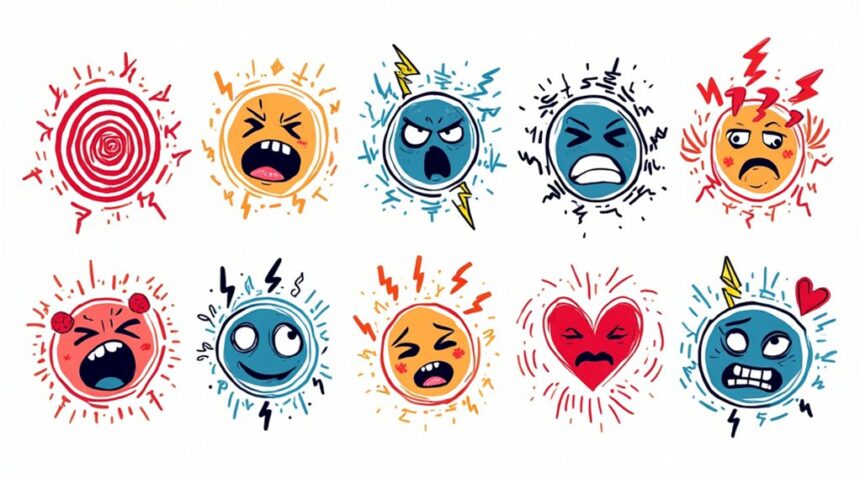
Leave a Reply